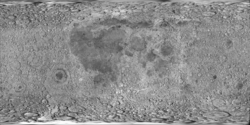| Fourier (cráter) Cráter lunar | ||
|---|---|---|
 Imagen de la misión Lunar Orbiter 4 (Líneas negras en el postproceso del original) | ||
| Coordenadas | 30°19′S 53°06′O / -30.31, -53.1 | |
| Diámetro | 51 km | |
| Profundidad | 3.7 km | |
| Colongitud | 54° al amanecer | |
| Epónimo | Jean-B. J. Fourier | |
|
Localización sobre el mapa lunar | ||

Fourier es un cráter de impacto que se encuentra en la parte suroeste de la cara visible de la Luna, justo al sureste del cráter Vieta. Al noreste se halla el Mare Humorum. El borde de este cráter es aproximadamente circular, pero parece ovalado cuando se ve desde la Tierra debido al escorzo.
 |
Excepto en el norte-noroeste, el borde exterior no está muy erosionado. El cráter satélite Fourier B se encuentra en el lado interior del borde oriental. La pared interior es relativamente amplia al estar ligeramente desplomada, formando una grada cerca del perímetro. El suelo interior abarca un poco más de la mitad del diámetro total del cráter, y es relativamente llano, con un pequeño cráter al oeste del punto medio y otro cerca del borde noreste.
Cráteres satélite
Por convención estos elementos son identificados en los mapas lunares poniendo la letra en el lado del punto medio del cráter que está más cerca de Fourier.
 Lunar Reconnaissance Orbiter |
|
Véase también
Referencias
- (WGPSN), IAU Working Group for Planetary System Nomenclature (13 de febrero de 2013). «Gazetteer of Planetary Nomenclature. 1:1 Million-Scale Maps of the Moon» (en inglés). UAI / USGS. Consultado el 6 de abril de 2016.
- Andersson, L. E.; Whitaker, E. A., (1982). NASA Catalogue of Lunar Nomenclature (en inglés). NASA RP-1097.
- Blue, Jennifer (25 de julio de 2007). «Gazetteer of Planetary Nomenclature» (en inglés). USGS. Consultado el 2 de enero de 2012.
- Bussey, B.; Spudis, P. (2004). The Clementine Atlas of the Moon (en inglés). Nueva York: Cambridge University Press. ISBN 0-521-81528-2.
- Cocks, Elijah E.; Cocks, Josiah C. (1995). Who's Who on the Moon: A Biographical Dictionary of Lunar Nomenclature (en inglés). Tudor Publishers. ISBN 0-936389-27-3.
- McDowell, Jonathan (15 de julio de 200). «Lunar Nomenclature» (en inglés). Jonathan's Space Report. Consultado el 2 de enero de 2012.
- Menzel, D. H.; Minnaert, M.; Levin, B.; Dollfus, A.; Bell, B. (1971). «Report on Lunar Nomenclature by The Working Group of Commission 17 of the IAU». Space Science Reviews (en inglés) 12: 136.
- Moore, Patrick (2001). On the Moon (en inglés). Sterling Publishing Co. ISBN 0-304-35469-4.
- Price, Fred W. (1988). The Moon Observer's Handbook (en inglés). Cambridge University Press. ISBN 0521335000.
- Rükl, Antonín (1990). Atlas of the Moon (en inglés). Kalmbach Books. ISBN 0-913135-17-8.
- Webb, Rev. T. W. (1962). Celestial Objects for Common Telescopes, 6ª edición revisada (en inglés). Dover. ISBN 0-486-20917-2.
- Whitaker, Ewen A. (2003). Mapping and Naming the Moon (en inglés). Cambridge University Press. 978-0-521-54414-6.
- Wlasuk, Peter T. (2000). Observing the Moon (en inglés). Springer. ISBN 1-85233-193-3.
- «Lunar Impact Crater Database» (en inglés). Lunar and Planetary Institute (USRA). Consultado el 12 de septiembre de 2017.
Enlaces externos
- Referencia UAI del CRÁTER
- LPI Digital Lunar Orbiter Photographic Atlas of the Moon
- Mapa LROC
 Wikimedia Commons alberga una categoría multimedia sobre Fourier.
Wikimedia Commons alberga una categoría multimedia sobre Fourier.

